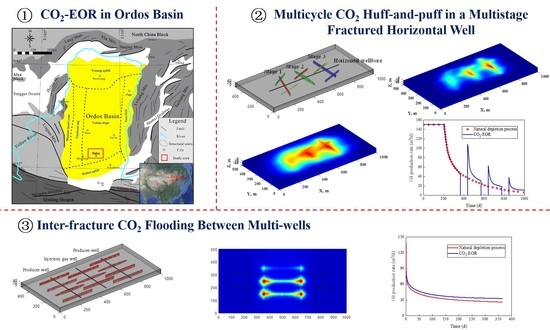Application of 3D Embedded Discrete Fracture Model for Simulating CO2-EOR and Geological Storage in Fractured Reservoirs
Abstract
:1. Introduction
2. Methodology
2.1. Basic Assumptions and Governing Equations
2.2. Finite Volume Discretization of Flow Equations for 3D-EDFM
2.3. Characterization of CO2 Physical Properties Change
3. Model Validation
4. Application Cases
4.1. Multicycle CO2 Huff-and-Puff in a Multistage Fractured Horizontal Well
4.2. Inter-Fracture CO2 Flooding between Multi-Wells
5. Conclusions
Author Contributions
Funding
Institutional Review Board Statement
Informed Consent Statement
Data Availability Statement
Acknowledgments
Conflicts of Interest
References
- Zhou, Y.B.; Chen, X.; Tan, X.; Liu, C.Y.; Zhang, S.N. Mechanism of CO2 Emission Reduction by Global Energy Interconnection. Glob. Energy Interconnect. 2018, 1, 11–21. [Google Scholar]
- Zhang, X.; Geng, Y.; Shao, S.; Dong, H.J.; Wu, R.; Yao, T.L.; Song, J.K. How to Achieve China’s CO2 Emission Reduction Targets by Provincial Efforts?—An Analysis Based on Generalized Divisia Index and Dynamic Scenario Simulation. Renew. Sustain. Energy Rev. 2020, 127, 109892. [Google Scholar] [CrossRef]
- Paul, B.; Extavour, M. CCUS: Utilizing CO2 to Reduce Emissions. Chem. Eng. Prog. 2016, 6, 52–59. [Google Scholar]
- Yan, Y.L.; Borhani, T.N.; Subraveti, S.G.; Pai, K.N.; Prasad, V.; Rajendran, A.; Nkulikiyinka, P.; Asibor, J.O.; Zhang, Z.E.; Shao, D.; et al. Harnessing the Power of Machine Learning for Carbon Capture, Utilisation, and Storage (CCUS)—A State-of-the-art Review. Energy Environ. Sci. 2021, 14, 6122–6157. [Google Scholar] [CrossRef]
- Hasan, M.M.F.; First, E.L.; Boukouvala, F.; Floudas, C.A. A Multi-scale Framework for CO2 Capture, Utilization, and Sequestration: CCUS and CCU. Comput. Chem. Eng. 2015, 81, 2–21. [Google Scholar] [CrossRef] [Green Version]
- Ji, L.; Yu, H.; Li, K.K.; Yu, B.; Grigore, M.; Yang, Q.; Wang, X.L.; Chen, Z.L.; Zeng, M.; Zhao, S.F. Integrated Absorption-mineralisation for Low-energy CO2 Capture and Sequestration. Appl. Energy 2018, 225, 356–366. [Google Scholar] [CrossRef]
- Akindipe, D.; Saraji, S.; Piri, M. Salt Precipitation during Geological Sequestration of Supercritical CO2 in Saline Aquifers: A Pore-scale Experimental Investigation. Adv. Water Resour. 2021, 155, 104011. [Google Scholar] [CrossRef]
- Harris, J.; Kovscek, A. Geological Storage of Carbon Dioxide Technical Report Global Climate and Energy Project (GCEP); Stanford University: Stanford, CA, USA, 2009. [Google Scholar]
- Hajiabadi, S.H.; Bedrikovetsky, P.; Borazjani, S.; Mahani, H. Well Injectivity during CO2 Geosequestration: A Review of Hydro-Physical, Chemical and Geomechanical Effects. Energy Fuels 2021, 35, 9240–9267. [Google Scholar] [CrossRef]
- Bachu, S. Identification of Oil Reservoirs Suitable for CO2-EOR and CO2 Storage (CCUS) Using Reserves Databases, with Application to Alberta, Canada. Int. J. Greenh. Gas Control. 2016, 44, 152–165. [Google Scholar] [CrossRef]
- Welkenhuysen, K.; Rupert, J.; Compernolle, T.; Ramirez, A.; Swennen, R.; Piessens, K. Considering Economic and Geological Uncertainty in the Simulation of Realistic Investment Decisions for CO2-EOR Projects in the North Sea. Appl. Energy 2017, 185, 745–761. [Google Scholar] [CrossRef]
- Cai, M.Y.; Su, Y.L.; Elsworth, D.; Li, L.; Fan, L.Y. Hydro-mechanical-chemical Modeling of Sub-nanopore Capillary-confinement on CO2-CCUS-EOR. Energy 2021, 225, 120203. [Google Scholar] [CrossRef]
- Zhao, J.Y.; An, X.P.; Wang, J.; Fan, J.M.; Kang, X.M.; Tian, X.Q.; Li, W.Q. A Quantitative Evaluation for Well Pattern Adaptability in Ultra-low Permeability Oil Reservoirs: A Case Study of Triassic Chang 6 and Chang 8 Reservoirs in Ordos Basin. Petrol. Explor. Dev. 2018, 45, 125–132. [Google Scholar] [CrossRef]
- Wang, Y.; Hou, J.R.; Song, Z.J.; Yuan, D.Y.; Zhang, J.W.; Zhao, T. Simulation Study of In-Situ CO2 Huff-n-Puff in Low Permeability Fault-Block Reservoirs. In Proceedings of the 2015 SPE Asia Pacific Oil & Gas Conference & Exhibition, Nusa Dua, Bali, Indonesia, 20–22 October 2015; p. 176327. [Google Scholar]
- Yang, Z.G.; Yue, X.G.; Shao, M.L.; Yang, Y.; Yan, R.J. Monitoring of Flooding Characteristics with Different Methane Gas Injection Methods in Low-Permeability Heterogeneous Cores. Energy Fuels 2021, 35, 3208–3218. [Google Scholar] [CrossRef]
- Shen, H.; Yang, Z.H.; Li, X.C.; Peng, Y.; Lin, M.Q.; Zhang, J.; Dong, Z.X. CO2-responsive Agent for Restraining Gas Channeling during CO2 Flooding in Low Permeability Reservoirs. Fuel 2021, 292, 120306. [Google Scholar] [CrossRef]
- Cao, R.Y.; Xu, X.Z.; Cheng, L.S.; Peng, Y.Y.; Wang, Y.; Guo, Z.L. Study of Single Phase Mass Transfer between Matrix and Fracture in Tight Oil Reservoirs. Geofluids 2019, 2019, 1038412. [Google Scholar] [CrossRef]
- Jia, P.; Cheng, L.S.; Huang, S.J.; Liu, H.J. Transient Behavior of Complex Fracture Networks. J. Pet. Sci. Eng. 2015, 132, 1–17. [Google Scholar] [CrossRef]
- Warren, J.; Root, P. The behavior of Naturally Fractured Reservoirs. SPE J. 1963, 3, 245–255. [Google Scholar] [CrossRef] [Green Version]
- Kazemi, H.; Seth, M.S.; Thomas, G.W. The Interpretation of Interference Tests in Naturally Fractured Reservoirs with Uniform Fracture Distribution. SPE J. 1969, 9, 463–472. [Google Scholar]
- Swann, A.D. Analytical Solution for Determining Naturally Fractured Reservoir Properties by Well Testing. SPE J. 1976, 16, 117–122. [Google Scholar]
- Al-Ahmadi, H.A.; Wattenbarger, R.A. Triple-porosity Models: One Further Step towards Capturing Fractured Reservoirs Heterogeneity. In Proceedings of the 2011 SPE/DGS Saudi Arabia Section Technical Symposium and Exhibition, Al-Khobar, Saudi Arabia, 15–18 May 2011; p. 149054. [Google Scholar]
- Al-Ahmadi, H.A. A Triple-Porosity Model for Fractured Horizontal Wells. Ph.D. Thesis, Texas A&M University, College Station, TX, USA, 2010. [Google Scholar]
- Jones, J.R.; Volz, R.; Diasmari, W. Fracture Complexity Impacts on Pressure Transient Responses from Horizontal Wells Completed with Multiple Hydraulic Fracture Stages. In Proceedings of the 2013 SPE Unconventional Resources Conference Canada, Calgary, AB, Canada, 5–7 November 2013; p. 167120. [Google Scholar]
- Cipolla, C.L. Modeling Production and Evaluating Fracture Performance in Unconventional Gas Reservoirs. J. Pet. Technol. 2009, 61, 84–90. [Google Scholar] [CrossRef]
- Cipolla, C.L.; Williams, M.J.; Weng, X.W.; Mack, M.G.; Maxwell, S.C. Hydraulic Fracture Monitoring to Reservoir Simulation: Maximizing Value. In Proceedings of the 2010 SPE Annual Technical Conference and Exhibition, Florence, Italy, 19–22 September 2010; p. 133877. [Google Scholar]
- Lee, S.H.; Jensen, C.L.; Lough, M.F. Efficient Finite-Difference Model for Flow in a Reservoir with Multiple Length-Scale Fractures. SPE J. 2000, 5, 268–275. [Google Scholar] [CrossRef]
- Moinfar, A.; Varavei, A.; Sepehrnoori, K.; Johns, R. Development of an Efficient Embedded Discrete Fracture Model for 3D Compositional Reservoir Simulation in Fractured Reservoirs. SPE J. 2014, 19, 289–303. [Google Scholar] [CrossRef] [Green Version]
- Moinfar, A.; Sepehrnoori, K.; Johns, R.T.; Varavei, A. Coupled Geomechanics and Flow Simulation for An Embedded Discrete Fracture Model. In Proceedings of the 2013 SPE Reservoir Simulation Symposium, Woodlands, TX, USA, 18–20 February 2013; p. 163666. [Google Scholar]
- Tene, M.; Bosma, S.B.M.; Al Kobaisi, M.S.; Hajibeygi, H. Projection-based Embedded Discrete Fracture Model (pEDFM). Adv. Water Resour. 2017, 105, 205–216. [Google Scholar] [CrossRef]
- Rao, X.; Cheng, L.S.; Cao, R.Y.; Jia, P.; Liu, H.; Du, X.L. A Modified Projection-based Embedded Discrete Fracture Model (pEDFM) for Practical and Accurate Numerical Simulation of Fractured Reservoir. J. Petrol. Sci. Eng. 2020, 187, 106852. [Google Scholar] [CrossRef]
- Cao, R.Y.; Fang, S.D.; Jia, P.; Cheng, L.S.; Rao, X. An Efficient Embedded Discrete-fracture Model for 2D Anisotropic Reservoir Simulation. J. Petrol. Sci. Eng. 2019, 174, 115–130. [Google Scholar] [CrossRef]
- Rao, X.; Cheng, L.S.; Cao, R.Y.; Jia, P.; Wu, Y.H.; He, Y.M.; Chen, Y. An Efficient Three-dimensional Embedded Discrete Fracture Model for Production Simulation of Multi-stage Fractured Horizontal Well. Eng. Anal. Bound. Elem. 2019, 106, 473–492. [Google Scholar] [CrossRef]
- Chen, Y.H.; Wang, Y.B.; Guo, M.Q.; Wu, H.Y.; Li, J.; Wu, W.T.; Zhao, J.Z. Differential Enrichment Mechanism of Organic Matters in the Marine-continental Transitional Shale in Northeastern Ordos Basin, China: Control of Sedimentary Environments. J. Nat. Gas. Sci. Eng. 2020, 83, 103625. [Google Scholar] [CrossRef]
- Dranchuk, P.M.; Kassem, H. Calculation of Z Factors for Natural Gases Using Equations of State. J. Can. Petrol. Technol. 1975, 14, 86–91. [Google Scholar] [CrossRef]
- Lee, A.L.; Gonzalez, M.H.; Eakin, B.E. The Viscosity of Natural Gases. J. Pet. Technol. 1966, 18, 997–1000. [Google Scholar] [CrossRef]
- Du, X.L.; Cheng, L.S.; Chen, J.; Cai, J.C.; Niu, L.Y.; Cao, R.Y. Numerical Investigation for Three-Dimensional Multiscale Fracture Networks Based on a Coupled Hybrid Model. Energies 2021, 14, 6354. [Google Scholar] [CrossRef]
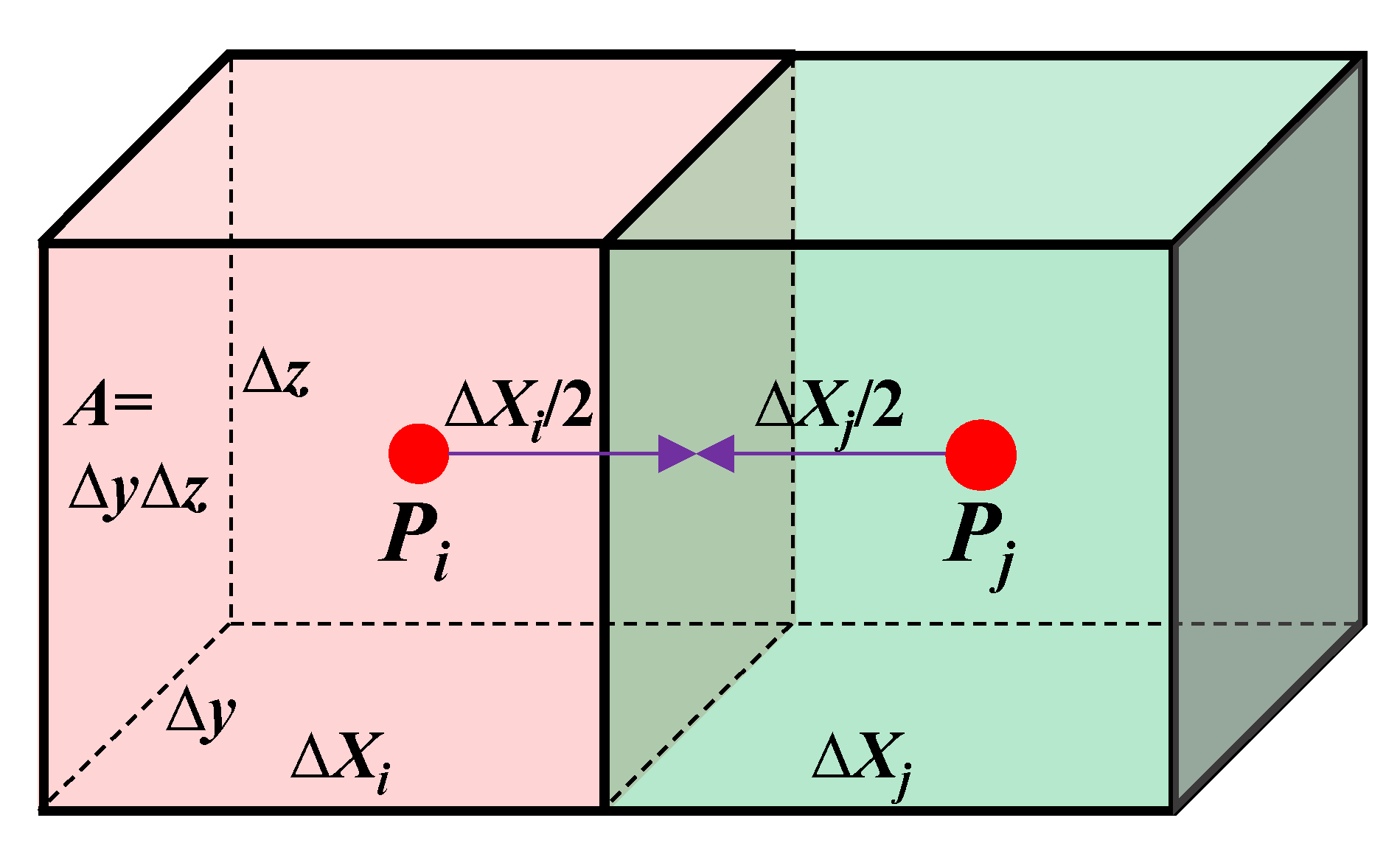

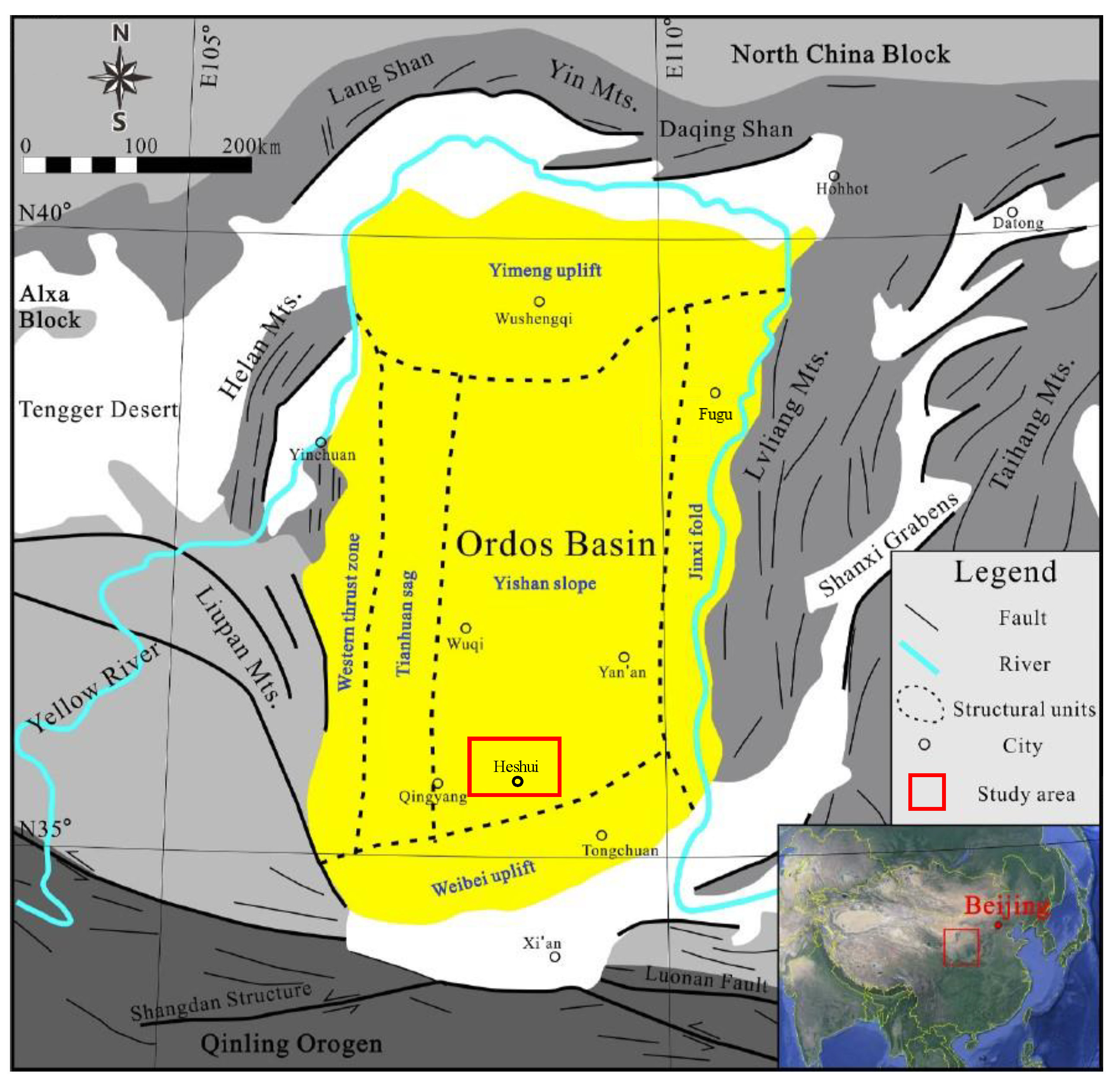
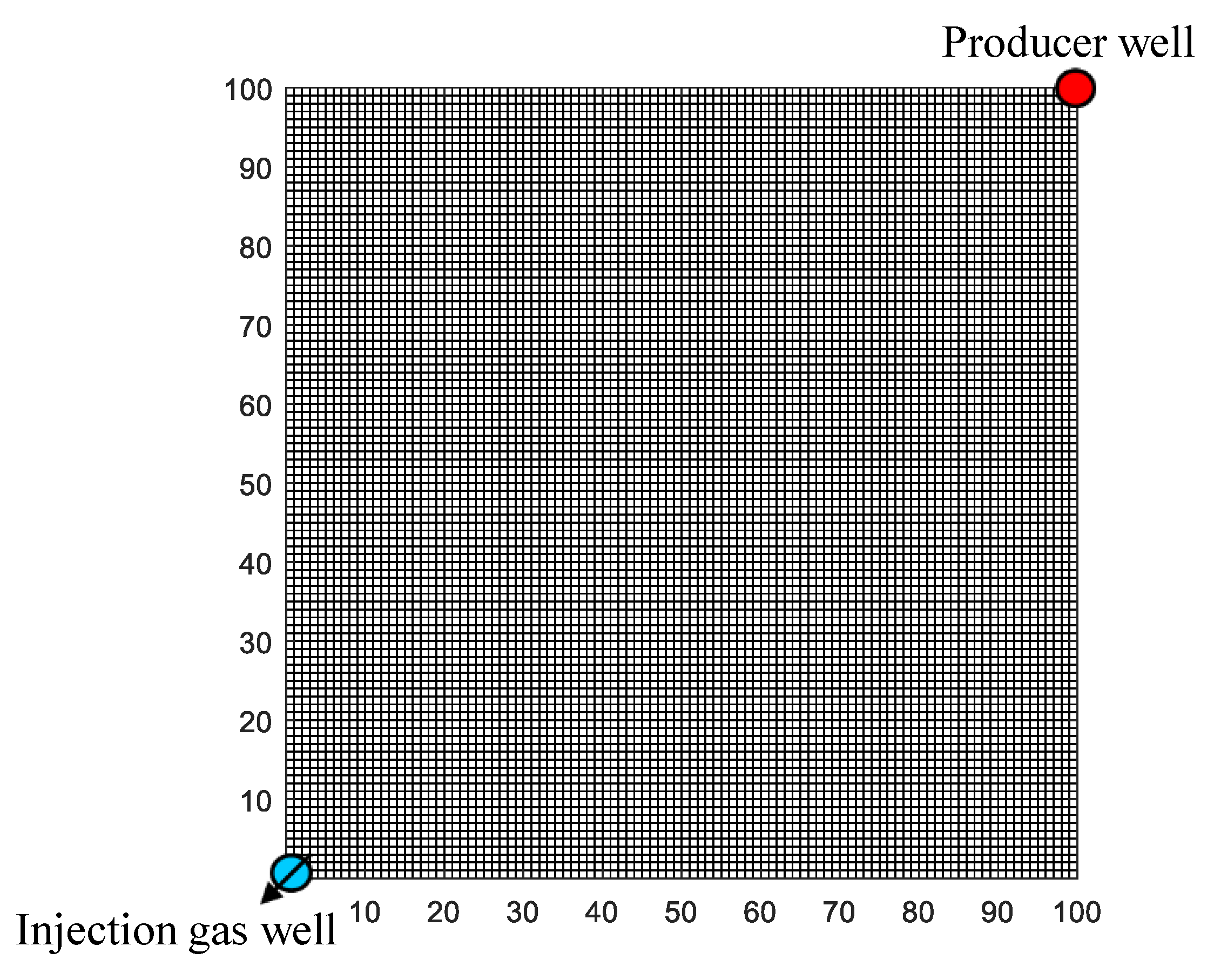
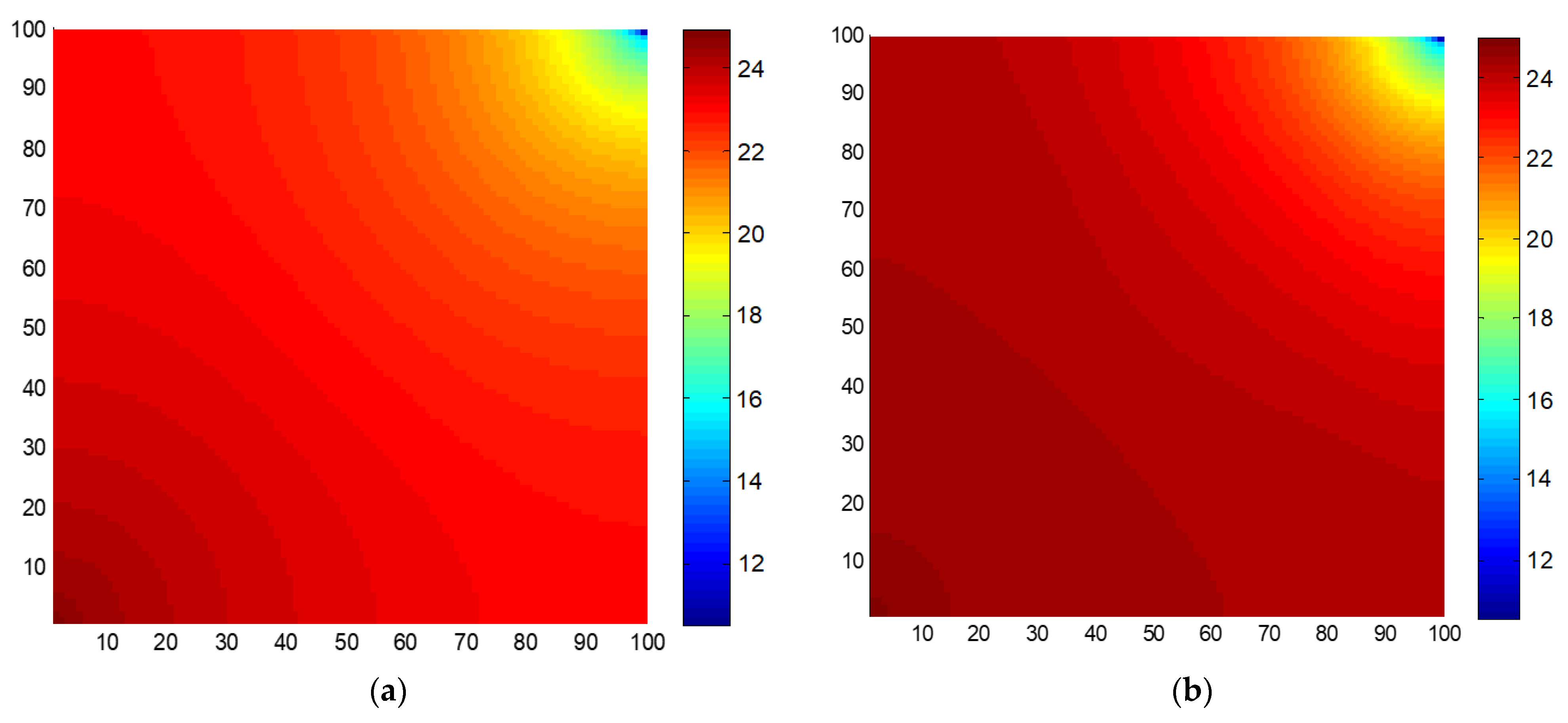
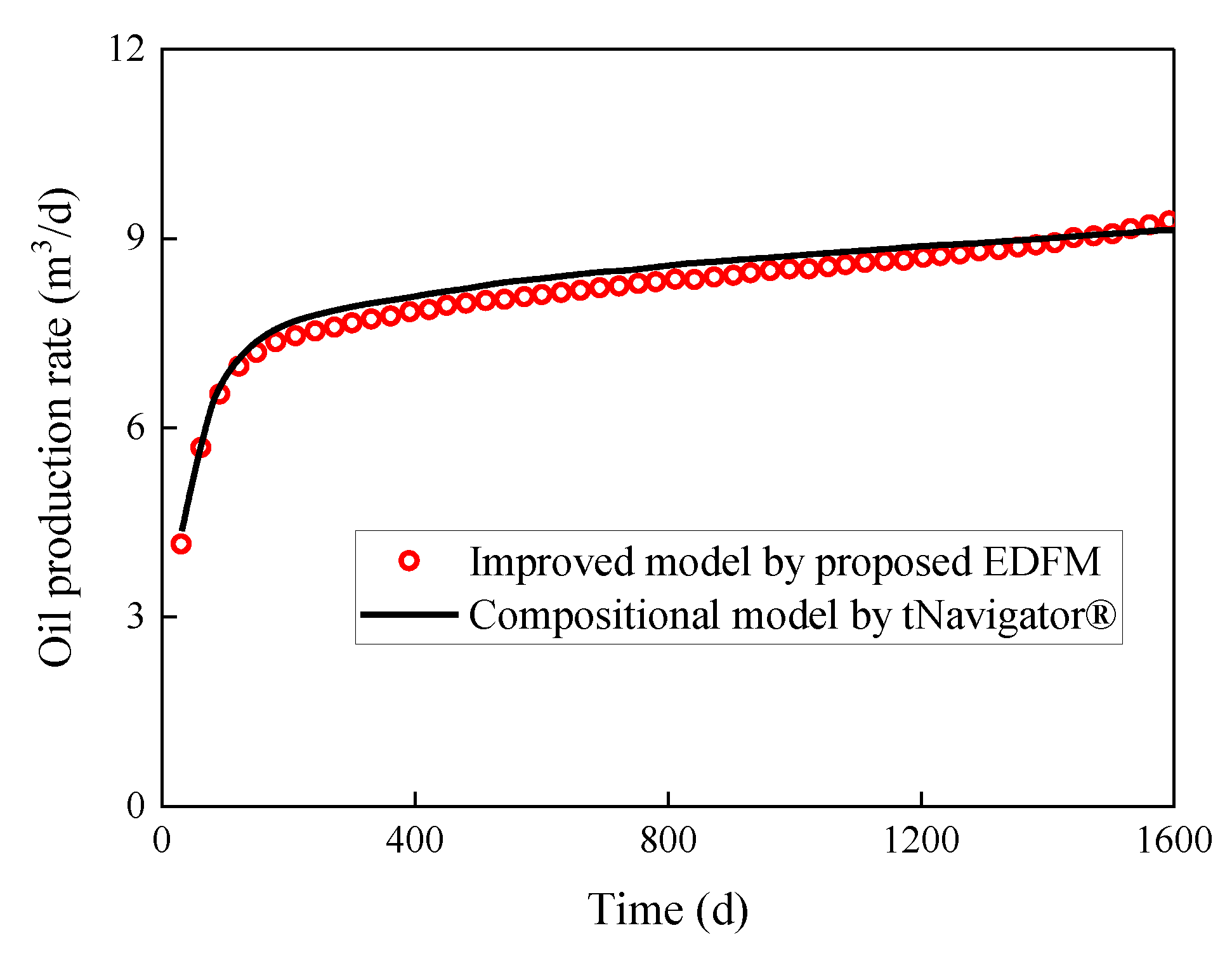
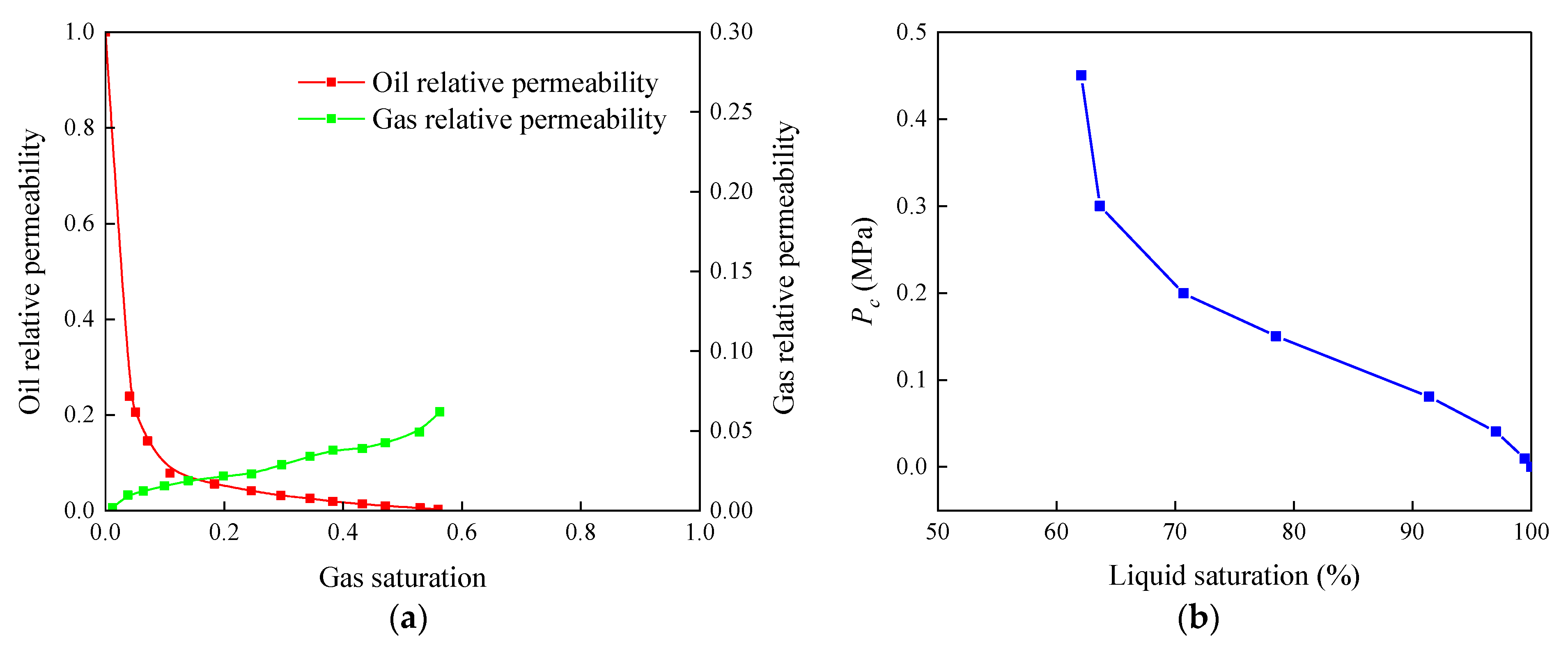
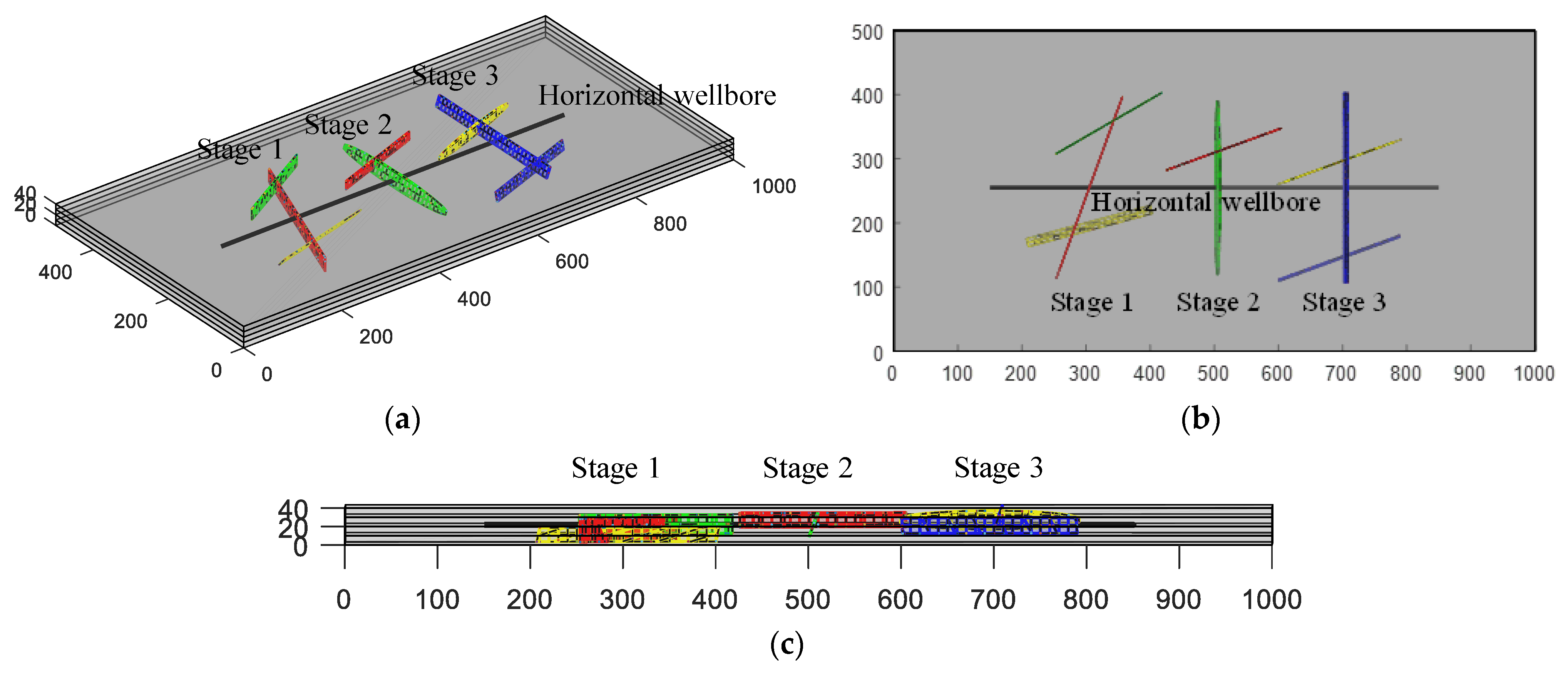
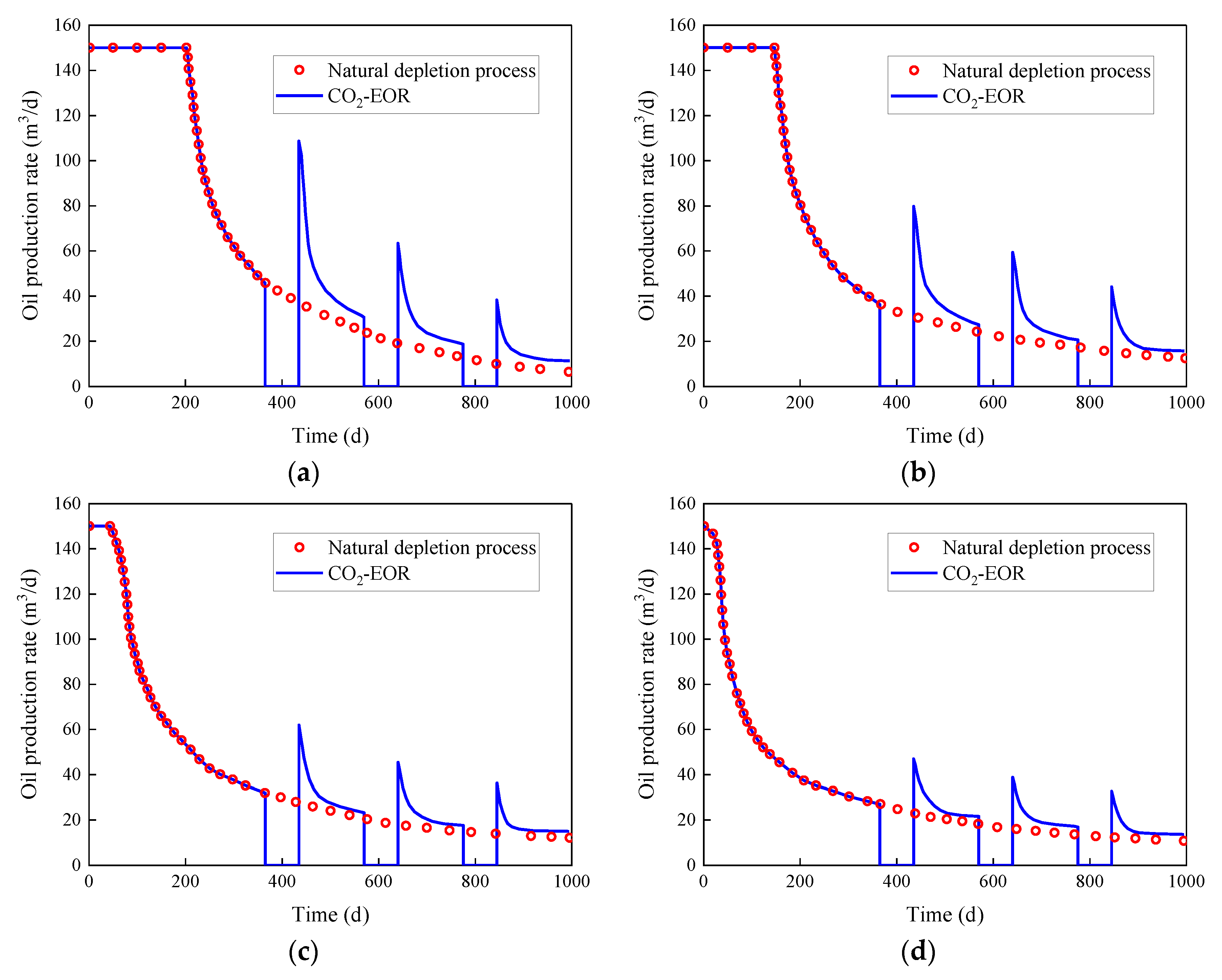
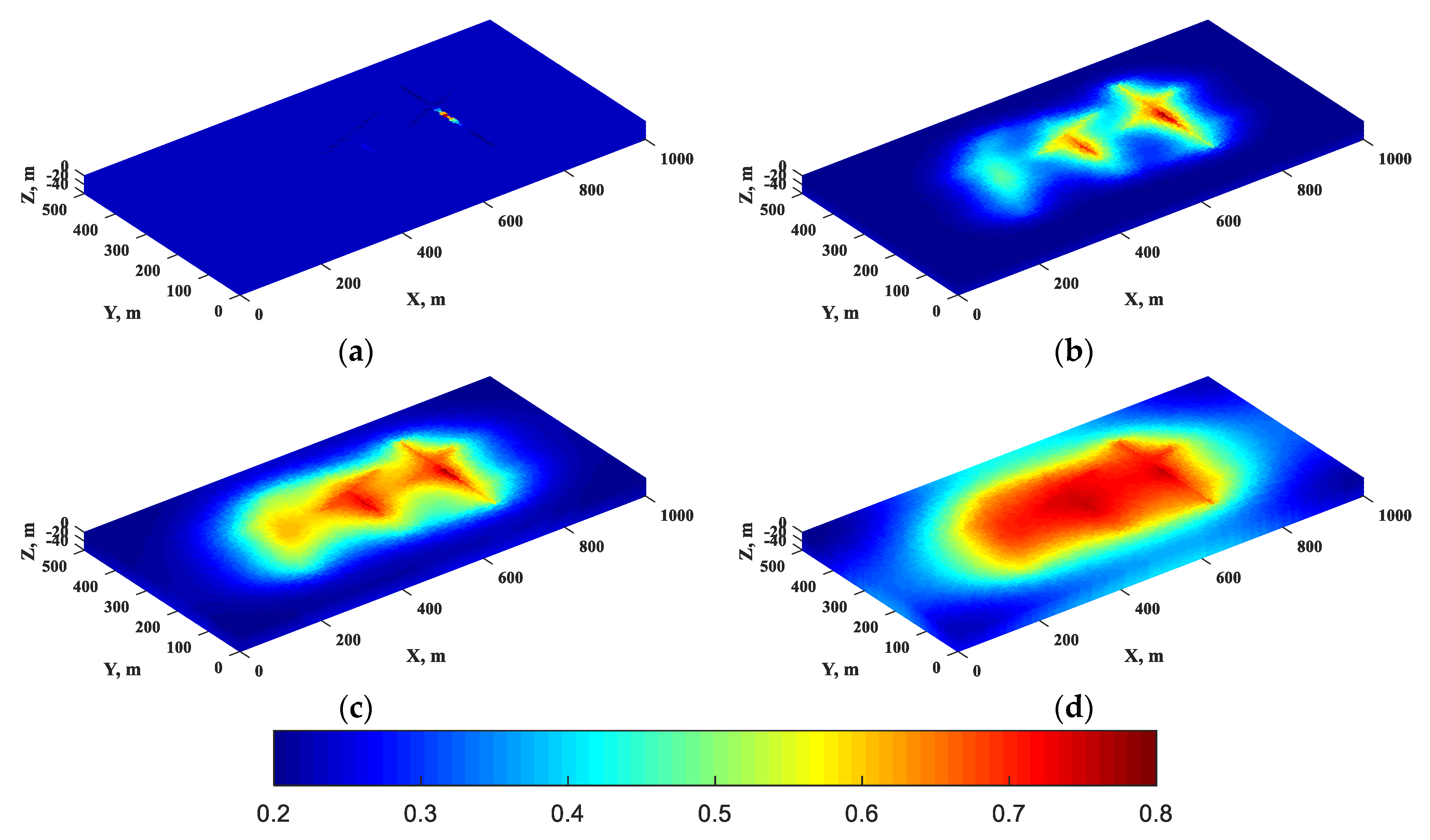
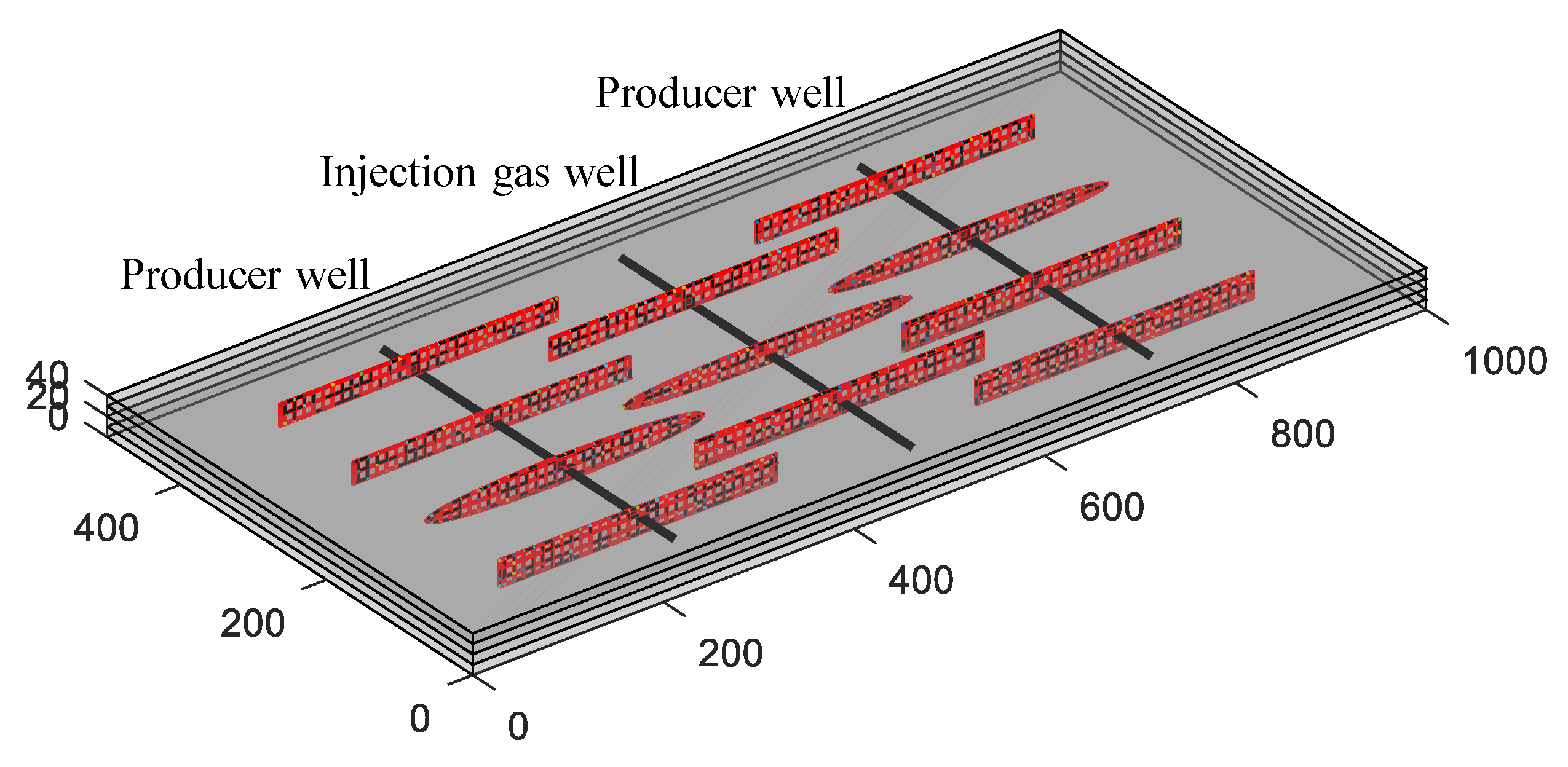
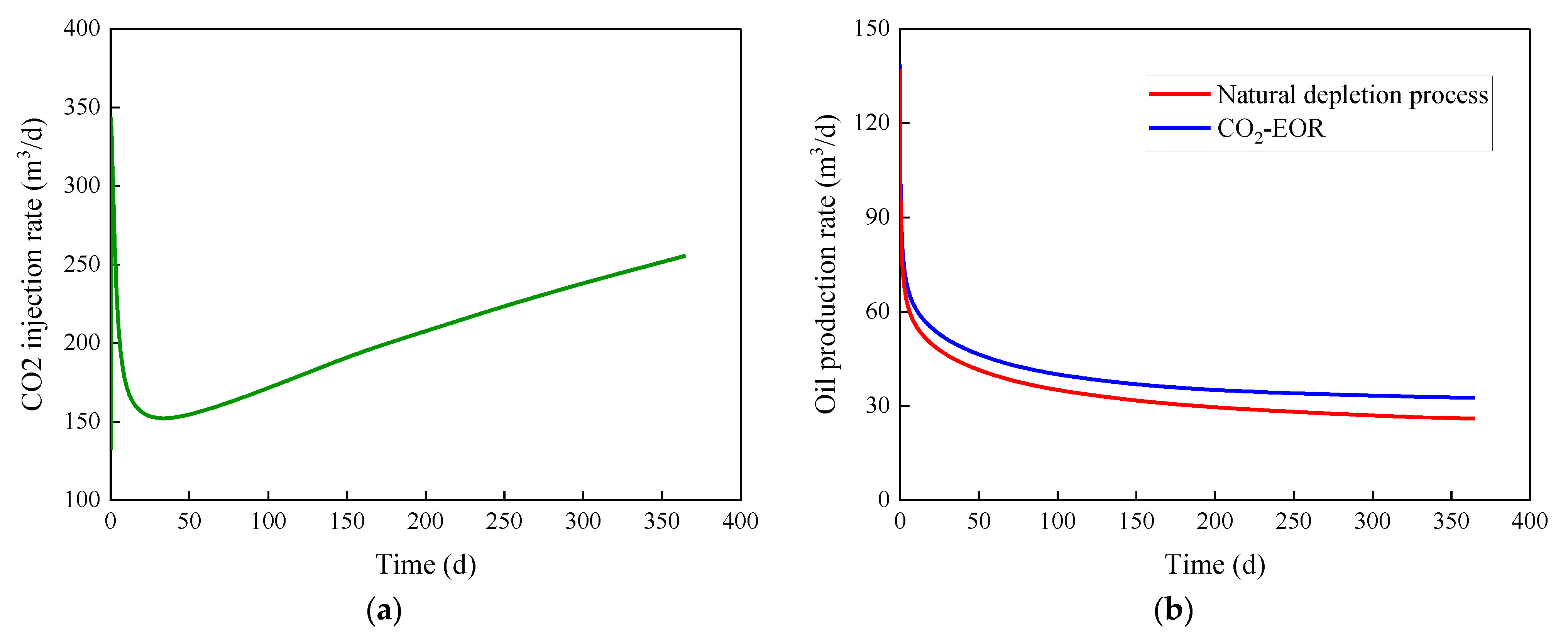
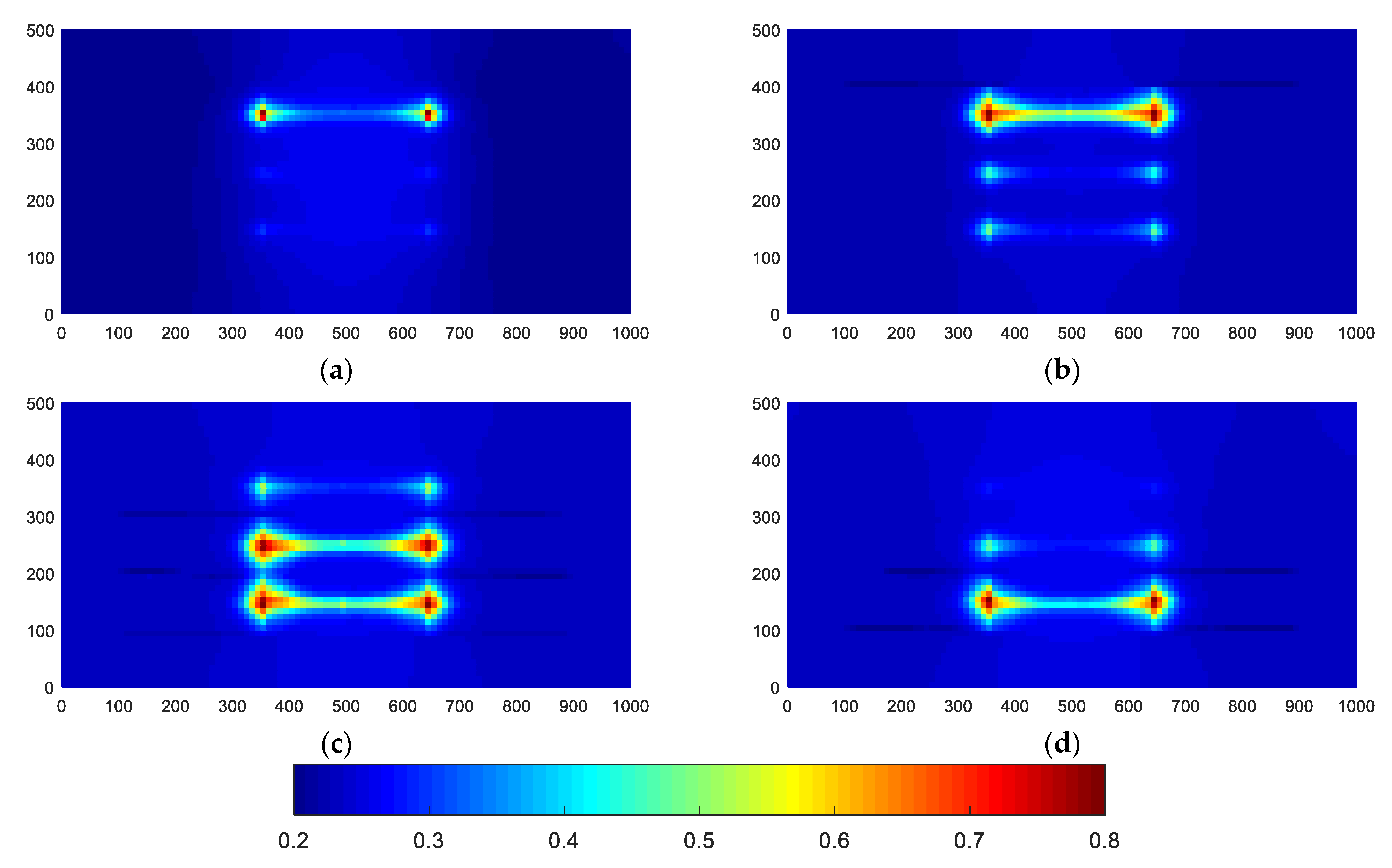
| Reservoir Pressure, MPa | The Volume Coefficient of CO2, m3/m3 | The Viscosity of CO2, mPa·s |
|---|---|---|
| 3.45 | 0.030 | 0.012 |
| 6.90 | 0.012 | 0.016 |
| 10.34 | 0.007 | 0.026 |
| 15.17 | 0.005 | 0.041 |
| 17.93 | 0.005 | 0.047 |
| 20.69 | 0.005 | 0.052 |
| 23.45 | 0.004 | 0.057 |
| 25.52 | 0.004 | 0.061 |
| 27.03 | 0.004 | 0.063 |
| 28.97 | 0.004 | 0.066 |
| Properties | Value | Properties | Value |
|---|---|---|---|
| Grid size, m | 1 × 1 × 10 | Initial reservoir pressure, MPa | 14.1 |
| Number of grids | 100 × 100 × 1 | CO2 density (SC), g/L | 1.96 |
| Initial oil saturation, fraction | 0.8 | Initial gas–oil ratio, m3/m3 | 68.17 |
| Reservoir depth, m | 1600 | Oil density (SC), kg/m3 | 820 |
| Layer thickness, m | 10 | Rock compressibility, MPa −1 | 1.07 × 10−4 |
| Injection pressure, MPa | 25 | Production pressure, MPa | 10 |
| Properties | Value | Properties | Value |
|---|---|---|---|
| Reservoir volume, m | 1000 × 500 × 30 | Grid number | 100 × 50 × 3 |
| Reservoir depth, m | 1500 | Initial reservoir pressure, MPa | 30 |
| Well diameter, m | 0.178 | Skin factor, fraction | 0.1 |
| Rock compressibility, MPa−1 | 1.07 × 10−4 | Fracture aperture, m | 0.01 |
| Matrix porosity, fraction | 0.17 | Fracture porosity, fraction | 0.4 |
| Matrix permeability, mD | 1 | Fracture permeability, mD | 20,000 |
| CO2 density (SC), g/L | 1.96 | Oil density (SC), kg/m3 | 820 |
| Oil viscosity, mPa·s | 2 | Oil compressibility, MPa−1 | 3.02 × 10−3 |
Publisher’s Note: MDPI stays neutral with regard to jurisdictional claims in published maps and institutional affiliations. |
© 2022 by the authors. Licensee MDPI, Basel, Switzerland. This article is an open access article distributed under the terms and conditions of the Creative Commons Attribution (CC BY) license (https://creativecommons.org/licenses/by/4.0/).
Share and Cite
Du, X.; Cheng, L.; Cao, R.; Zhou, J. Application of 3D Embedded Discrete Fracture Model for Simulating CO2-EOR and Geological Storage in Fractured Reservoirs. Atmosphere 2022, 13, 229. https://doi.org/10.3390/atmos13020229
Du X, Cheng L, Cao R, Zhou J. Application of 3D Embedded Discrete Fracture Model for Simulating CO2-EOR and Geological Storage in Fractured Reservoirs. Atmosphere. 2022; 13(2):229. https://doi.org/10.3390/atmos13020229
Chicago/Turabian StyleDu, Xulin, Linsong Cheng, Renyi Cao, and Jinchong Zhou. 2022. "Application of 3D Embedded Discrete Fracture Model for Simulating CO2-EOR and Geological Storage in Fractured Reservoirs" Atmosphere 13, no. 2: 229. https://doi.org/10.3390/atmos13020229
APA StyleDu, X., Cheng, L., Cao, R., & Zhou, J. (2022). Application of 3D Embedded Discrete Fracture Model for Simulating CO2-EOR and Geological Storage in Fractured Reservoirs. Atmosphere, 13(2), 229. https://doi.org/10.3390/atmos13020229





